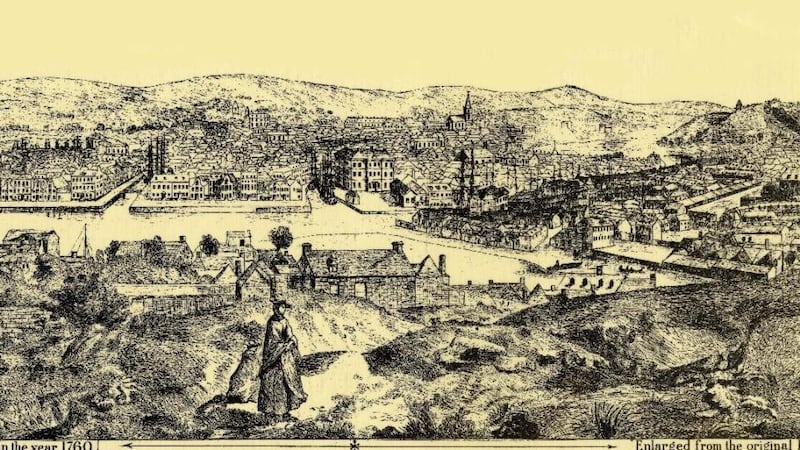What is it?
John Butts's View of Cork from Audley Place is a fine topographical view of Cork city, probably painted around 1750. The old Custom House, now the Crawford Gallery, is visible in the centre of the composition. One of the two observers in the foreground points out St Anne's Church tower in Shandon. Part of the water to the left was soon the site of urban expansions and is now partly occupied by Patrick Street.
How was it done?
Butts's picture cleverly stitches together two distinct views of the city from north of the Lee so that they blend convincingly into a whole that would not be entirely visible from a single viewpoint. Born in 1728, Butts apprenticed as a landscape painter and produced many paintings of the countryside around Cork, mingling factual and invented elements in line with prevailing pictorial fashion. He manages the sweep of this topographic view very effectively and it confirms his reported skill with colour, light and shade. His figures, though, have what Peter Murray has termed a "plasticine" quality. The presence of a dog in also a trademark in his paintings.
Where can I see it?
The painting takes centre stage in Under the Goldie Fish in the Modern Galleries of the Crawford Art Gallery, Emmet Place Cork (crawfordartgallery.ie) until August 19th. The title is from Cork-born writer Cónal Creedon's cult 1990s radio programme, chronicling the lives of a cast of fantasy characters under the golden fish weather vane on St Anne's Church. The exhibition offers a topographical, artists' eyes' view of Cork's evolving urban fabric from the 18th century onwards. Works from the Crawford's collection by Nathanial Grogan, Eileen Healy, Harry Moore and Robert Lowe Stopford also feature.

Is it a typical work by the artist?
Not quite. Of great historical interest, View of Cork is a jewel in the crown of the collection of Cork Crawford Art Gallery. Previously attributed to another artist, Nathaniel Grogan, and in a private collection, it was purchased by the McCarthy family at auction in 2005 and gifted to the Crawford, when there was still some debate about who had in fact painted it. Some 12 years Butts' junior, Grogan actually studied for a time with the older artist and the confusion over authorship is understandable given the overlaps and similarities between them. Like Butts, Grogan came from a working class background, and he too struggled to survive as an artist without the benefit of affluent patrons. It's not the only time the unlucky Butts was at the centre of questions of authorship: he is also thought to have painted works previously attributed to George Barret and Thomas Roberts. Despite being adept and industrious, he struggled to make a living in Cork and, with his wife and children, moved to Dublin in 1757, where he worked as a scene-painter at the Crow Street Theatre (by no means the only artist to turn to scene-painting to make ends meet). He tried to establish himself as a painter and won the occasional commission but sold little. His erratic habits – including, reportedly, his drinking – told against him and he resorted to sign painting and hackwork, selling humorous bar-room sketches for pennies, for example. He was in dire financial straits when he died, in 1765.













